
This appliance is not intended for use by young or inrm persons unless supervised by a
responsible person to ensure that they can use the appliance safely. Young children should be
supervised to ensure that they do not play with the appliance.
WARNING! Before connecting a tool to a power source (mains switch power
point receptacle, outlet, etc.) be sure that the voltage supply is the same as that specied on the
nameplate of the tool. A power source with a voltage greater than that specied for the tool can result
in serious injury to the user,as well as damage to the tool. If in doubt, do not plug in the tool.
Using a power source with a voltage less than the nameplate rating is harmful to the
motor.
Your tool is double insulated for additional protection against a possible electrical insulation failure
within the tool.
Always remove the plug from the mains socket before making any adjustments or
maintenance, including changing the blade.
• When operating the saw, use safety equipment including safety goggles or shield, ear protection,
dust mask and protective clothing including safety gloves.
• Ensure that there is adequate general or localised lighting.
• Do not use the saw unless the guards are in place.
• Do not use the saw to cut metal or masonry.
• Do not let anyone under 18 years operate this saw.
• Ensure that the operator is adequately trained in the use, adjustment and operation of the
machine.
• Do not use this saw to cut rewood.
• Keep the area free of tripping hazards.
• Report faults in the machine, including guards and saw blades, as soon as they are discovered.
• Ensure that the machine is always xed to a bench, whenever possible.
• Always stand to one side when operating the saw.
• Never use a cracked or distorted saw blade.
• When cutting round wood, use clamps that prevent the workpiece from turning on both sides of the
blade.
• Never use your hands to remove sawdust, chips or waste close by the blade.
• Do not use blades of High Speed Steel (HSS blades).
• If the table insert is damaged or worn, have it replaced by a power tool repairer.
• Rags, cloths, cord and string and the like should never be left around the work area.
• Avoid cutting nails. Inspect the workpiece and remove all nails and other foreign objects before
operating the saw.
• Support the work properly.
• Refrain from removing any cut-offs or other parts of the workpiece from the cutting area whilst the
machine is running and the saw head is not in the rest position.
• Do not attempt to free a jammed blade before rst switching off the machine.
• Do not slow or stop a blade with a piece of wood. Let the blade come to rest without assistance.
• If you are interrupted when operating the saw, complete the process and switch off before looking
up.
• Periodically check that all nuts, bolts and other xings are properly tightened.
• Do not store materials or equipment above a machine in such a way that they could fall into it.
• Always hold the saw on parts that are insulated. If you accidentally cut into hidden wiring or the
saw’s own cable, the metal parts of the saw will become “live”. Switch off at the mains and remove
the plug immediately.
• Never saw near combustible liquids or gases.
• Note the direction of rotation of the motor and the blade.
• Do not lock the movable guard in the open position and always ensure that it is working properly,
freely rotating and returning to fully cover the teeth of the blade.
• Connect the saw to a dust collection device and ensure that it is operating properly. As the
operator of the saw, please make sure that you understand factors that inuence exposure to dust,
including the type of material to be cut, the importance of local extraction and the proper
adjustment of hoods/bafes/chutes of your dust extraction system. We recommend that you
always wear a dust mask when operating this saw.
• Wear gloves when handling saw blades and rough materials.
• Saw blades shall be carried in a holder wherever possible.
• Select saw blades in relation to the material being cut.
• Use correctly sharpened saw blades and observe the maximum speed marked on the blade.
• Take additional care when trenching (slotting).
• The mitre saw can be safely carried by the carrying handle but only once it has been removed
from the mains power and secured in the locked down position.
• Ensure that the arm is properly secure when bevelling.
• Keep the oor area around the machine level, well maintained and free of loose materials.
• Ensure that you are trained in the use, adjustment and operation of the machine.
• Do not remove any cut-offs from the cutting area until the mitre saw head is in the full upright
position, the blade guard is fully enclosing the blade and the blade has come to a rest or complete
stop.
• When cutting long pieces which extend well over the table width, ensure that the ends are
adequately supported at the same height as the saw table top. Supports should be positioned in
such a way to ensure that the workpiece does not fall to the ground once the cut has been made.
Operating Mitre Saws with out the correct hearing protection may result in impairment of hearing.
A number of supports at regular intervals may be required if the workpiece is extremely long.
- Wear goggles
- Wear earmuffs
- Wear a breathing mask
MITRE SAW SAFETY WARNINGS
WARNING! When using mains-powered tools, basic safety precautions, including the
following, should always be followed to reduce risk of re, electric shock, personal injury
and material damage.
Read the whole manual carefully and make sure you know how to switch the tool off in an emergency, before
operating the tool.
Save these instructions and other documents supplied with this tool for future reference.
The electric motor has been designed for 230V and 240V only. Always check that the power supply
corresponds to the voltage on the rating plate.
Note: The supply of 230V and 240V on Ozito tools are interchangeable for Australia and New Zealand.
This tool is double insulated therefore no earth wire is required.
If the supply cord is damaged, it must be replaced by an electrician or a power tool repairer in order to avoid
a hazard.
Note: Double insulation does not take the place of normal safety precautions when operating this tool. The
insulation system is for added protection against injury resulting from a possible electrical insulation failure
within the tool.
Using an Extension Lead
Always use an approved extension lead suitable for the power input of this tool. Before use, inspect the
extension lead for signs of damage, wear and ageing. Replace the extension lead if damaged or defective.
When using an extension lead on a reel, always unwind the lead completely. Use of an extension lead not
suitable for the power input of the tool or which is damaged or defective may result in a risk of re and electric
shock.
WARNING! Read all safety warnings and all instructions. Failure to follow the warnings and
instructions may result in electric shock, re and/or serious injury.
Save all warnings and instructions for future reference. The term “power tool” in the warnings refers
to your mains-operated (corded) power tool or battery-operated (cordless) power tool.
1. Work area safety
a. Keep work area clean and well lit. Cluttered or dark areas invite accidents.
b. Do not operate power tools in explosive atmospheres, such as in the presence of ammable
liquids, gases or dust. Power tools create sparks
which may ignite the dust or fumes.
c. Keep children and bystanders away while operating a power tool. Distractions can cause you to
lose control.
2. Electrical safety
a. Power tool plugs must match the outlet. Never modify the plug in any way.
Do not use any adapter plugs with earthed (grounded) power tools. Unmodied plugs and matching
outlets will reduce risk of electric shock.
b. Avoid body contact with earthed or grounded surfaces, such as pipes, radiators, ranges and
refrigerators. There is an increased risk of electric shock
if your body is earthed or grounded.
c. Do not expose power tools to rain or wet conditions. Water entering a power tool will increase the
risk of electric shock.
d. Do not abuse the cord. Never use the cord for carrying, pulling or unplugging the power tool.
Keep cord away from heat, oil, sharp edges or moving parts. Damaged or entangled cords increase
the risk of electric shock.
e. When operating a power tool outdoors, use an extension cord suitable
for outdoor use. Use of a cord suitable for outdoor use reduces the risk of electric shock.
f. If operating a power tool in a damp location is unavoidable, use a residual current device (RCD)
protected supply. Use of an RCD reduces the risk of electric shock.
3. Personal safety
a. Stay alert, watch what you are doing and use common sense when operating a power tool. Do
not use a power tool while you are tired or under the inuence of drugs, alcohol or medication. A
moment of inattention while operating power tools may result in serious personal injury.
b. Use personal protective equipment. Always wear eye protection. Protective equipment such as dust
mask, non-skid safety shoes, hard hat, or hearing protection used for appropriate conditions will reduce
personal injuries.
c. Prevent unintentional starting. Ensure the switch is in the off-position before connecting to
power source and/or battery pack, picking up or carrying the tool. Carrying power tools with your
nger on the switch or energising power tools that have the switch on invites accidents.
d. Remove any adjusting key or wrench before turning the power tool on.
A wrench or a key left attached to a rotating part of the power tool may result
in personal injury.
e. Do not overreach. Keep proper footing and balance at all times. This enables better control of the
power tool in unexpected situations.
f. Dress properly. Do not wear loose clothing or jewellery. Keep your hair, clothing and gloves away
from moving parts. Loose clothes, jewellery or long hair can be caught in moving parts.
g. If devices are provided for the connection of dust extraction and collection facilities, ensure
these are connected and properly used. Use of dust collection can reduce dust-related hazards.
4. Power tool use and care
a. Do not force the power tool. Use the correct power tool for your application. The correct power tool
will do the job better and safer at the rate for which it was designed.
b. Do not use the power tool if the switch does not turn it on and off. Any power tool that cannot be
controlled with the switch is dangerous and must be repaired.
c. Disconnect the plug from the power source and/or the battery pack from the power tool before
making any adjustments, changing accessories, or storing power tools. Such preventive safety
measures reduce the risk of starting the power tool accidentally.
d. Store idle power tools out of the reach of children and do not allow persons unfamiliar with the
power tool or these instructions to operate the power tool. Power tools are dangerous in the hands
of untrained users.
e. Maintain power tools. Check for misalignment or binding of moving parts, breakage of parts and
any other condition that may affect the power tool’s operation. If damaged, have the power tool
repaired before use. Many accidents are caused by poorly maintained power tools.
f. Keep cutting tools sharp and clean. Properly maintained cutting tools with sharp cutting edges are
less likely to bind and are easier to control.
g. Use the power tool, accessories and tool bits etc. in accordance with these instructions, taking
into account the working conditions and the work to be performed. Use of the power tool for
operations different from those intended could result in a hazardous situation.
5. Service
a. Have your power tool serviced by a qualied repair person using only identical replacement
parts. This will ensure that the safety of the power tool
is maintained.
b. If the supply cord is damaged, it must be replaced by the manufacturer,
its service agent or similarly qualied persons in order to avoid a hazard.
GENERAL POWER TOOL SAFETY WARNINGS - PERSONAL SAFETY
ELECTRICAL SAFETY

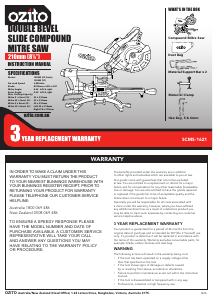


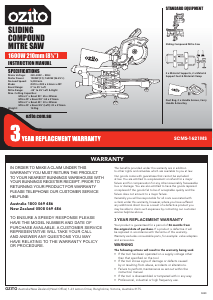
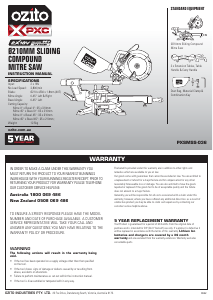

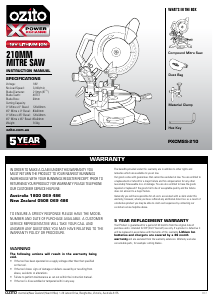
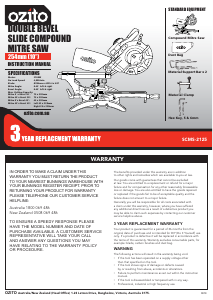


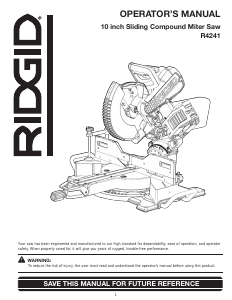
Join the conversation about this product
Here you can share what you think about the Ozito SCMS-1621 Mitre Saw. If you have a question, first carefully read the manual. Requesting a manual can be done by using our contact form.
reply | This was helpful (0)